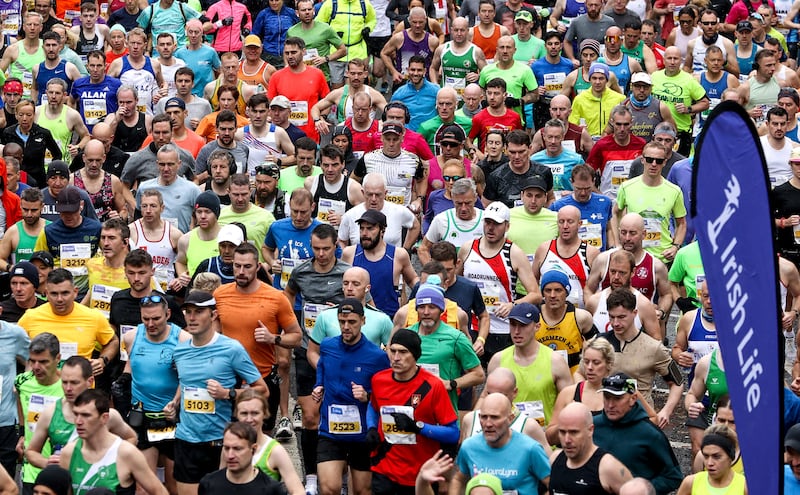The 43rd running of the Irish Life Dublin Marathon is all set for this Sunday, October 27th, and effectively follows the same 26.2-mile route as recent years, only with two pivotal changes: the start line, and the finish line.
There was some talk after last year’s event that the start and finish might be moved out of the city centre altogether, given the “disproportionate adverse impact” the race has on public transport services, although thankfully sense prevailed and the changes are quite minimal.
Like every other year, all marathon journeys are about reaching your destination: the finish! Here’s everything else you need to know:
Q. So what are those exact changes to the start and finish compared to last year?
The new start line is on Leeson Street Lower, shortly before entering on to St Stephen’s Green, and then 26.2 miles later it will finish on Mount Street Upper, remaining within the Dublin 2 area.
READ MORE
This represents only a minor adjustment to previous years, when the race started on Fitzwilliam Street Upper and finished on Merrion Square North.
Q. What about the actual start times?
In all, the Dublin Marathon event will have five start times, starting with the wheelchair participants at 8.40am. They will be followed by wave 1 at 8.45am, wave 2 at 9.05am, wave 3 at 9.25am and wave 4 at 9.45am.
The main advice from Dublin Marathon race director Jim Aughney is that because the new start line on Leeson Street is about 3m narrower than last year, runners should give themselves a little more time to get to the start and also ensure they’ve dropped off their baggage at Merrion Square.
Plan for at least an hour before, allowing time for a very gentle 10-minute jog. The clocks going back on Saturday night also afford an extra hour in bed, remember!
Make sure you’re also well familiar with the start area and race-entry routes.
The course remains open for seven hours from when the last person crosses the start line.
Q. Any chance of a late entry?
Eh, absolutely no chance. All 22,500 entries are long since sold out, with around 40,000 entry requests in all. There was a longer entry transfer window this year, up to the end of August, which organisers hope will reduce the number of runners unable to make the start line on the day.
Q. What about picking up my race number?
This can only happen in person at the Dublin Marathon Expo in the Main Hall of the RDS this Friday, October 25th (12pm-7pm) and then Saturday, October 26th (9am-6pm). Remember to bring some ID (Passport, Student Photo, Driving License or Government Issued Photo ID, etc).
The cut-off time for pack collection is 6pm on Saturday. After all those long, hard miles clocked up by now, there’s no excuse for missing that. Remember at the baggage drop-off, only the clear plastic bags provided at registration are allowed.
Q. So I’ve designated my wave start, but can I swap?
Wave positions are allocated by your own predicted finishing times, and while moving up a wave is not allowed, runners can choose to move down a wave. It doesn’t make any difference in the end anyway, your start time only begins once you cross the starting line.
Q. Should I consider following one of the designated Dublin Marathon pacers?
Dublin provides several different sets of pacers on the day, and if you’re confident and feeling safe in your target finish time, this is definitely a good idea.
The pacers run at a steady effort throughout, aiming to finish a few seconds under each time band. Pacers are allocated to each wave as follows: Wave 1- 3:00, 3:10, 3:20; Wave 2 – 3:30, 3:40, 3:50; Wave 3 – 4:00, 4:10, 4:20; Wave 4 – 4:30, 4:40, 4:50, 5:00.
There is no requirement to sign up or commit to any pacing group in advance. Simply turn up at your wave start, look for the pacing runners wearing large balloons, and stand in behind the corresponding time.

Q. Is it better to track my progress in miles or kilometres?
It doesn’t matter what you’re counting – the 138,336ft or 60,000-odd strides for that matter – it doesn’t get any shorter, and there are certainly no shortcuts. However, the Dublin Marathon is only marked at every mile, and every 5km, and also the halfway point.
Although the marathon, remember, really only starts at 20 miles!
Q. Should I consider bringing my own water?
This should not be necessary, unless that’s already been a part of your training routine. Like every big city marathon, Dublin has ample refreshment stations – 10 in total. Look at the route map and note in advance where exactly they are.
Also note what’s on offer: 250ml bottles of Ishka water are provided, the Lucozade Sport stations serve cups in a variety of flavours, High5 gels are also supplied at two stations on the route. But if you haven’t tried that particular brand before, Sunday is probably not the time to do so.
Q. Where is the best place to watch?
There are several Irish Life Support Zones along the course, as well at the Irish Life Mile, which is a designated support area for a one-mile stretch down Northumberland Road, approaching the finish.
For friends and family who are unable to attend and show their support on the day, live streaming will be available for the entire duration of the marathon on the Dublin Marathon YouTube channel.
Those living or working near or along the race route can find full details of the road closures on Sunday at www.irishlifedublinmarathon.ie/traffic-information/
Good luck to all!
















